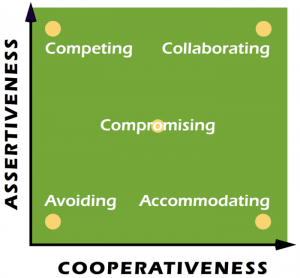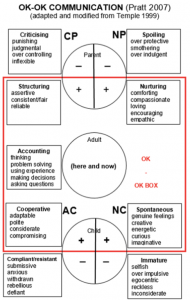Models for dealing with conflict in one-to-one communication settings
Over the past few months, we may have been managing conflict in many guises, given the current extraordinary circumstances of Covid-19 lockdown in the UK and around the world, and the challenges that proximity…or the opposite… has brought. We all have our individual coping mechanisms; I’ve noticed a tendency for some close friends to distance themselves, not wishing to communicate much at all: others have been more communicative than usual.
For many of us living in households of several people, perhaps of different generations, with limited space and opportunity to get out (though that is easing), this can put even further strain on us and our relationships. We have the additional unusual conditions of intertwined personal and business lives. You or a partner might have been furloughed, or working from home when you’re not set up to do so. You might be providing home schooling when you’re ill-equipped, and untrained, for this work. All these factors can be a huge challenge, adding to the stress many are experiencing from so much uncertainty. Conflict is inevitable during these situations, so conflict resolution seemed like a useful topic to address, focussing specifically on the dynamic between two people.
There are two methods, or tools, for resolving conflict that I’ve had some training in and experience with in the last few years. These are Transactional Analysis (TA), which I first came across in the early 80s, and the Thomas-Kilmann Conflict Mode Instrument, which I only discovered as recently as 2017.
Those of you working in HR and Organisational Development (OD) will probably be familiar with both models, so please forgive the over-simplification. I’m not an expert in either system; links to further resources are provided at the end of the article. In these past few months, I have found elements of both models useful and hope they might provide the same for you.
In the 1970s, Kenneth Thomas and Ralph Kilmann developed five conflict resolution strategies that they observed people use in handling conflict. That is, in a situation where the concerns of two people appeared incompatible.
These strategies are underpinned by two dimensions of an individual’s behaviour: assertiveness and cooperativeness (see diagram on left).
- competing – assertive and uncooperative
- accommodating – unassertive and cooperative
- avoiding – unassertive and uncooperative
- compromising – moderate in both assertiveness and cooperativeness
- collaborating – assertive and cooperative
Although each of us is capable of using all five conflict-resolving strategies, some of us tend to favour one or two over the others, perhaps because we are more adept at using them, whether through practise or temperament. The problem with doing this is that different strategies are often required for different situations. In an emergency situation, for example, a competing strategy is probably more effective than an avoiding strategy
Are you aware of using one of these strategies more than another? If so, have you found it more or less effective in specific situations, or with certain people? What might be the outcome of practising a different strategy? Has being at home more had an effect on your conflict-resolving strategies?
Like many systems, they are constantly evolving. Five decades on, Ralph Kilmann has developed the Kilmann Organizational Conflict Instrument (link provided below).
Even earlier (in the late 50s), Eric Berne developed the now well-established Transactional Analysis (TA), publishing the best-selling book ‘Games People Play’ in the early 60s.
If you’re unfamiliar with TA, the simplest way to describe the system is that it assumes we are always interacting with each other in a combination of various ego states, i.e. parent, adult, child. These are broken down further. The adjectives have changed and developed over the years. Modern TA has a number of variations. The basic states are:-
ParenT: Nurturing or Controlling
Adult: Neutral position
Child: Natural/Free or Adapted
These ego states are all based on our experiences, but the parent and child states have usually been internalised by behaviour we experienced or observed as children. People often have a preferred mode, but we can all take any position in an interaction.
No doubt you can imagine the sorts of things a controlling parent might say, or a nurturing one. The same is probably true of a free or a rebellious child. All of these can be useful, but in terms of resolving conflict, adult-to-adult communication is usually the most effective. The behaviour and language tends to be neutral, emotionally mature and constructive.
Over the years, one TA tool that I’ve found useful for resolving conflict is to be aware (it sounds simple, but not always easy) of the position I’m taking, as follows:-
I’m OK, you’re OK (+OK, +OK)
I’m OK, you’re not OK (+OK, -OK)
I’m not OK, you’re not OK (-OK, -OK)
I’m not OK, you’re OK (-OK, +OK)
Sometimes, this awareness happens on reflection. Can you recall a recent conflict where it’s obvious to you what position you were taking? If you had shifted your perspective, how do you think the outcome might have differed? How could this system be useful to you in a future conflict-resolving situation?
If you’re interested in exploring these systems further, some resources are provided below. Here’s to us all dealing with and resolving conflict more constructively as lockdown lifts…and beyond
By Lynda Russell-Whitaker
Sources:
- https://www.researchgate.net/publication/265565339_Thomas-Kilmann_conflict_MODE_instrument
- https://kilmanndiagnostics.com/
- http://www.ericberne.com/transactional-analysis/
- http://www.ericberne.com/im-ok-youre-ok-by-thomas-a-harris/
- https://juliehay.org/
Download the PDF version of this article here: Resolving Conflict – at home and at work



